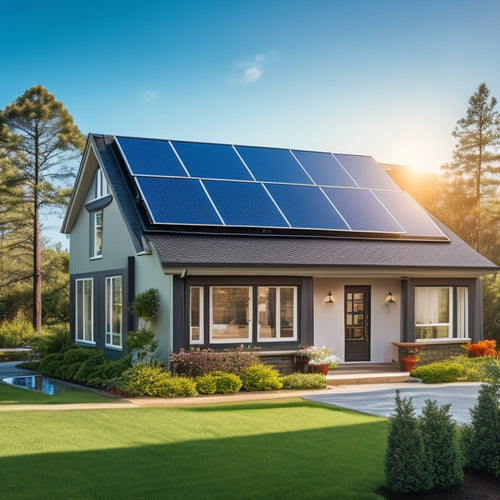
Small Solar Panels With Highly Efficient Battery Storage
Share
As you search for small solar panels with highly efficient battery storage, you're likely considering the benefits of generating electricity while occupying minimal space, reducing your carbon footprint, and gaining energy independence. You've got several options to choose from, including monocrystalline, thin-film, and bifacial solar panels, each with unique advantages suited for different installation needs. When it comes to battery storage, prioritize high energy density, long cycle life, and low self-discharge rates, with options like lithium-ion and flow batteries. By selecting the right combination of these components, you'll be well on your way to maximizing your energy independence and cost savings - and there's even more to investigate when it comes to optimizing your system's performance.
Key Takeaways
- Small solar panels with highly efficient battery storage offer energy independence, reduced carbon footprint, and cost savings on electricity bills.
- Monocrystalline, Thin-Film, and Bifacial solar panels cater to different installation needs, with Bifacial panels capturing energy from both sides for up to 25% increased output.
- Highly efficient battery options like Lithium-ion and Flow batteries prioritize high energy density, long cycle life, and low self-discharge rates for optimal performance.
- Energy storage system design involves inverter efficiency, battery type selection, charge controllers, and energy management systems for real-time monitoring and automated load shedding.
- Benefits of battery backup systems include storing excess solar energy, reducing grid reliance, and providing energy independence, long-term financial security, and cost savings.
Benefits of Small Solar Systems
When considering small solar panels, your primary focus is likely on their ability to generate electricity while taking up minimal space. However, these compact systems offer more benefits than just their physical footprint.
One significant advantage is their reduced environmental impact. By utilizing renewable energy from the sun, you'll decrease your reliance on fossil fuels and lower your carbon footprint. This not only helps combat climate change but also contributes to a cleaner, healthier environment.
Small solar systems also provide energy independence, allowing you to generate your own electricity and reduce your dependence on the grid. This is particularly beneficial for remote locations or areas with frequent power outages.
With a small solar panel system, you'll have control over your energy production and consumption, ensuring a consistent and reliable supply of power. Additionally, these systems are often more cost-effective than traditional energy sources, saving you money on your electricity bills.
Highly Efficient Battery Options
You've likely considered the benefits of small solar panels, including their reduced environmental impact and energy independence.
Now, it's crucial to pair these systems with highly efficient battery options to maximize their potential. When selecting a battery, you'll want to prioritize high energy density, long cycle life, and low self-discharge rates.
Lithium-ion batteries are a popular choice for small solar systems due to their high energy density and relatively low weight. They're well-suited for applications requiring high power and short duration discharges.
However, they can be prone to overheating and may require additional cooling systems.
Flow batteries, on the other hand, offer a more scalable and flexible solution. They store energy in a liquid electrolyte solution in external tanks, allowing for easier expansion or replacement of components.
Flow batteries are ideal for applications requiring long-duration discharges and can operate at a lower cost per kilowatt-hour.
When evaluating battery options, consider factors like depth of discharge, round-trip efficiency, and warranty duration to make sure you're getting the most out of your small solar panel system.
Small Scale Solar Panel Types
You'll find three primary types of small-scale solar panels, each with unique characteristics and benefits.
Monocrystalline silicon cells offer high efficiency rates, while thin-film photovoltaic cells provide a more affordable option.
Bifacial solar modules, which can capture energy from both sides of the panel, are also worth considering for your small solar panel setup.
Monocrystalline Silicon Cells
Your small-scale solar panel installation's most efficient option is likely to be monocrystalline silicon cells, which boast the highest conversion rates among all commercial solar panel types.
These cells are made from a single crystal of silicon, which provides a more efficient flow of electrons. As a result, monocrystalline silicon cells have higher solar cell efficiency, typically ranging from 15% to 20%.
The advantages of monocrystalline silicon cells are numerous. They perform better in low-light conditions and have a longer lifespan compared to other solar panel types.
Additionally, they occupy less space, making them ideal for small-scale solar panel installations where space is limited. Monocrystalline silicon cells also have a lower temperature coefficient, meaning their efficiency is less affected by high temperatures.
This results in a more consistent power output throughout the day. Overall, if you're looking for the most efficient option for your small-scale solar panel installation, monocrystalline silicon cells are the way to go.
Thin-Film Photovoltaic Cells
While monocrystalline silicon cells offer high-quality efficiency, thin-film photovoltaic cells provide a more affordable and flexible alternative for small-scale solar panel installations. You'll find that thin-film photovoltaic cells are made by depositing a thin layer of photovoltaic material on a substrate, resulting in a lighter and more flexible design. This design allows for easier installation and integration into various applications.
Thin-film photovoltaic cells offer several advantages, including:
| Advantages | Description |
|---|---|
| Lower Production Costs | Reduced material usage and simplified manufacturing processes |
| Increased Flexibility | Easier installation and integration into various applications |
| Improved Durability | Thinner design reduces mechanical stress and increases lifespan |
| Enhanced Aesthetics | Sleeker design and variety of colors available |
| Higher Temperature Tolerance | Better performance in high-temperature environments |
You can expect thin-film photovoltaic cells to have lower solar efficiency rates compared to monocrystalline silicon cells. However, their advantages make them an attractive option for small-scale solar panel installations where cost and flexibility are key considerations.
Bifacial Solar Modules
Among the various small-scale solar panel types, bifacial solar modules have gained significant attention in recent years due to their unique ability to capture energy from both the front and back sides of the panel.
You'll find that these modules can increase energy output by up to 25% compared to traditional monofacial panels, resulting in higher bifacial efficiency. This is because the back side of the panel can absorb reflected light from the surrounding environment, such as rooftops, grass, or sand.
The bifacial advantages don't stop there. These modules are also more durable and resistant to wear and tear, as the back side is protected from environmental elements.
Additionally, bifacial solar modules can be installed at a lower tilt angle, allowing for more flexibility regarding installation location and design.
When considering small-scale solar panel options, bifacial solar modules are definitely worth exploring, especially if you're looking to maximize energy output and reduce costs.
With their unique design and advantages, bifacial solar modules are an attractive choice for those seeking to utilize the power of the sun.
Energy Storage System Design
How efficiently can small solar panels charge your energy storage system? It's an essential question, as the answer directly impacts your ability to utilize renewable energy. The key lies in designing an energy storage system that seamlessly integrates with your small solar panels.
To achieve ideal energy management, you need to evaluate the following system integration factors:
| System Component | Design Considerations |
|---|---|
| Inverter | Efficiency rating, compatibility with solar panel output |
| Battery Type | Depth of discharge, cycle life, and charging speed |
| Charge Controller | Maximum power point tracking, overcharge protection |
| Energy Management System | Real-time monitoring, automated load shedding |
| System Monitoring | Remote access, data analytics, and alarm notifications |
Small Solar Panel Installation Tips
Most small-scale solar panel installations require careful planning to guarantee ideal energy harvesting. You'll need to contemplate the installation challenges that can affect your system's performance.
One vital aspect is optimal placement of your solar panels. Confirm they're installed at an angle that complements your location's latitude to maximize energy output. Additionally, reflect on the panel's orientation in relation to the sun's path; a south-facing installation is usually ideal.
When evaluating your roof's suitability, inspect for any obstructions, such as vents, skylights, or chimneys, that could cast shadows on your panels.
You'll also need to assess your roof's structural integrity to support the weight of the solar panels. Moreover, confirm that your installation complies with local building codes and regulations.
Cost Savings With Battery Backup
By optimizing your small solar panel installation, you've taken the first step towards utilizing renewable energy.
Now, it's time to reap the financial benefits of integrating a battery backup system. With a battery storage solution, you can store excess energy generated by your solar panels during the day for use during peak hours or at night. This reduces your reliance on the grid, leading to significant cost savings.
By investing in a battery backup system, you're making a long-term investment in your energy independence. You'll enjoy financial incentives like reduced electricity bills and potential tax credits.
Additionally, you'll be shielding yourself from rising energy costs and potential grid outages. With a battery backup system, you can optimize your energy usage, reduce waste, and maximize your return on investment.
In the long run, the cost savings from reduced energy consumption and peak-hour avoidance will more than justify the initial investment in your battery backup system.
Frequently Asked Questions
Can I Install Small Solar Panels on a Rental Property?
"When in Rome, do as the Romans do" - in this case, get your landlord's permission before installing small solar panels on a rental property, exploring installation options like roof-mounted or ground-mounted systems to guarantee a smooth process.
Are Small Solar Systems Suitable for Homes With Low Energy Usage?
You're wondering if small solar systems are suitable for homes with low energy usage. The answer is yes, as they're designed for energy efficiency and can be scaled up or down to match your specific needs, making them an ideal solution for energy-conscious homeowners.
Do Small Solar Panels Work Well in Areas With Frequent Shading?
You'll find that small solar panels can still generate power in areas with frequent shading, but you'll need to evaluate shading solutions, such as bifacial panels or tracker systems, to maximize efficiency improvements and optimize energy output.
Can I Use Small Solar Panels to Charge My Electric Vehicle?
You're wondering if you can utilize the sun's power to fuel your electric vehicle; yes, you can, but charging efficiency depends on solar panel types and your vehicle's charging system, so choose wisely to maximize your eco-friendly driving experience.
Are Small Solar Systems Compatible With Existing Electrical Infrastructure?
You're wondering if small solar systems can seamlessly integrate with existing electrical infrastructure. Fortunately, you'll find that modern systems prioritize grid integration, ensuring smooth system compatibility and efficient power distribution, allowing you to utilize renewable energy without disruptions.
Related Posts
-

Why Electric Motorcycles Fail at Long-Distance Touring
You're likely familiar with the excitement of hitting the open road on an electric motorcycle, but you're also smart ...
-

Planning for an Electric Vehicle-Friendly Urban Future
As you plan for an electric vehicle-friendly urban future, you'll need to integrate high-power charging stations, sma...
-

Solar Power Units Perfect for Homes
You're considering installing a solar power unit in your home, a decision that can notably reduce your reliance on tr...


